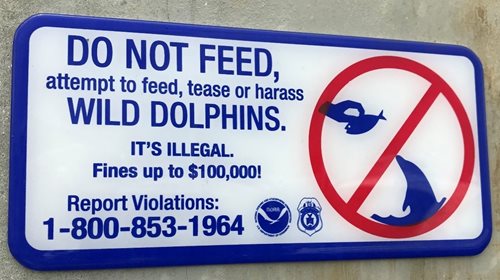News & Updates
Port Canaveral Launches Education Effort to Protect Wild Dolphins in Port Waters

Project is part of Port’s commitment to balance environmental preservation with needs of a growing Central Florida population
Port Canaveral, FL – Aug. 9, 2018 – In keeping with Port Canaveral’s commitment to environmental stewardship, a new visitor education program was initiated at the Port aimed at protecting wild dolphins swimming in waters surrounding the Port. New signage installed around the Port is part of an initiative in which Port Canaveral is participating that includes U.S. National Oceanic and Atmospheric Administration (NOAA) Fisheries and Hubbs-SeaWorld Research Institute’s Marine Mammal Stranding Program to remind the public of potential effects of feeding marine life and discarding fishing gear such as monofilament line, hooks and marine rope.
Port Environmental Director Bob Musser and Port Environmental Specialist Blair Englebrecht led a group effort of Port staff and summer interns to post new signage throughout the Port cautioning visitors not to feed, tease or harass wild dolphins. The group installed more than 40 adhesive-backed placards to concrete pillars, seawalls and pilings at key locations around the Port, including the Ocean Club Marina, Bluepoints Marina, the Port Canaveral Yacht Club, The Cove entertainment area, popular land and offshore fishing and charter boat locations and the Freddie Patrick Park Boat Ramp. Signs will soon be posted at the Rodney S. Ketcham Boat Ramp after upcoming seawall repairs are completed.
“Our commitment to strong environmental stewardship is just as great as our commitment to maintain Port Canaveral as a world-class gateway for cruises, cargo and recreation,“ Port CEO Captain John Murray stated. “As a proud Green Marine-certified Port, we want to remind our visitors of the Port’s responsibility to help protect these awe-inspiring marine mammals.”
The new signs state, “Do Not Feed, Attempt to Feed, Tease or Harass Wild Dolphins” and warn that such actions are illegal as specified under the federal Marine Mammal Protection act of 1972 and that violators could face up to a $100,000 fine. The placards include phone information for the NOAA Office of Law Enforcement to report violations.

Port Canaveral intern Aubrey Schrand applies placard at Ocean Club Marina (Photo: Canaveral Port Authority)
When fed, dolphins can lose their fear of humans and rely on handouts, or they might venture near fishermen and vessels to steal bait and hooked fish. Fishing lines or rope can entangle dolphins or cause them to choke on food.
About 60 dolphins are found dead each year in the Indian River, and fishing gear is blamed for several of those deaths. During the past year, Hubbs-SeaWorld rescued at least five entangled dolphins in the Indian River Lagoon, including two near Cocoa Beach.
The project is one of many Port Canaveral initiatives meant to protect the surrounding environment, including maintaining the federal navigation channel while re-nourishing beaches south of the inlet, monitoring water quality throughout the Port and Barge Canal, installing lighting that protects hatchlings of sea turtles that lay their eggs on nearby beaches and preserving native marine and plant species by removing invasive lionfish and exotic vegetation from the Port.
“Port Canaveral continuously strives for a sustainable balance between our responsibility to protect the environment and expanding the Port’s business,” said Port Environmental Director Bob Musser. “We appreciate the efforts of our Environmental staff and our hard-working interns who have helped us so much this summer, and we wish them much success in their upcoming school year and future careers.”
Participating interns included Katie Hughes, an intern this summer in the Port’s Environmental Department who coordinated the project. A Cocoa High School graduate, she will enter the University of Florida as a sophomore this fall, majoring in environmental engineering.

Port Environmental Director Bob Musser (far right) is joined by Port Environmental Specialist Blair Englebrecht (far left) and interns Aubrey Schrand (Missouri Baptist University graduate), Katie Hughes from Cocoa, FL, and Maine Maritime Academy interns Alexandra Bierman and Mikayla Charters (Photo: Canaveral Port Authority)
# # #
ABOUT PORT CANAVERAL
Led by the elected five-member Canaveral Port Authority Board of Commissioners and Port Director and CEO, Captain John Murray, Port Canaveral is one of the world’s most dynamic and exciting ports. A world-class gateway for cruises, cargo, recreation and logistics, as well as a gateway to new frontiers, including space, Port Canaveral hosts more than 4 million revenue cruise passengers through its state-of-the-art terminals and 5.5 million of tons of cargo annually, including bulk, break-bulk, project, and containerized. The Port is strategically located to service all Florida markets, as well as the Southeastern United States. In addition to world class cruise facilities and diverse cargo operations, Port Canaveral offers more recreational opportunities than all other Florida deep-water seaports combined, including public parks, free public boat ramps, marinas, an entertainment district, and the seven-story interactive exhibit and event venue Exploration Tower. For more information, visit www.PortCanaveral.com
Media Contact
Steve Linden
Director, Communications and Public Affairs
Tel: (321) 394-3244 | Cell: (321) 576-3282
Slinden@portcanaveral.com
